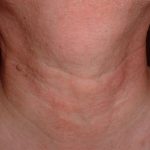 Junction of stem and root [unusual term, not recommended].
Junction of stem and root [unusual term, not recommended].
The supporting structure of the head, formed by the seven cervical vertebrae and lying between the head and the shoulders.
The part of the body which joins the head to the body.
A narrow part of a bone or organ.
Area of the body between the head and the trunk.
The narrow structure of the body that connects the trunk to the head. The neck is a complex structure of muscles, organs, blood vessels, and nerves surrounding the upper spine. Seven bones called the cervical vertebrae form the core of the neck and support the head. The cervical vertebrae fit together like a stack of rings, allowing them to rotate the head and move it back and forth. The spinal cord passes through the cervical vertebrae and into the trunk. A number of nerves, such as those connecting with the arm, branch off the spine in the neck.
The part of the body between the head and shoulders.
The region of the body that upholds the head and acts as a conduit connecting the head (including the brain) to the rest of the body is referred to as the neck. The neck houses a multitude of vital structures, including the spinal cord (responsible for transmitting nerve signals to and from the brain), the trachea (windpipe), the larynx (voice box), the esophagus (food pipe), the thyroid and parathyroid glands, lymph nodes, and numerous major blood vessels. Additionally, the neck accommodates seven spinal vertebrae, encircled by an intricate network of muscles.
Torticollis, also known as wry neck, can occur when the head becomes tilted to one side. This condition might arise from muscle damage in the neck or from skin shrinkage (contracture) following burns or other traumas. Furthermore, fractures and dislocations of neck vertebrae, along with injuries like whiplash, can lead to harm to the spinal cord, potentially resulting in paralysis or even fatal outcomes.
The deterioration of the joints connecting the vertebrae in the neck can arise due to cervical osteoarthritis, leading to discomfort, restricted movement, and occasionally tingling and arm and hand weakness. Comparable symptoms can also stem from a herniated disc. In cases of ankylosing spondylitis, the fusion of vertebrae may result in enduring neck stiffness.
Cervical rib is an infrequent innate anomaly characterized by a small additional rib located in the neck. Typically, this condition remains asymptomatic until middle age, at which point it might lead to discomfort, numbness, and a sensation akin to pins and needles in the forearm and hand.
Unexplained neck pain is a prevalent occurrence. Yet, as long as there are no accompanying neurological indications (like diminished muscle strength or sensory loss), the situation is unlikely to be severe and usually resolves within a few weeks. Nevertheless, any condition leading to substantial neck swelling (such as thyroid gland enlargement) might impede breathing or swallowing.
